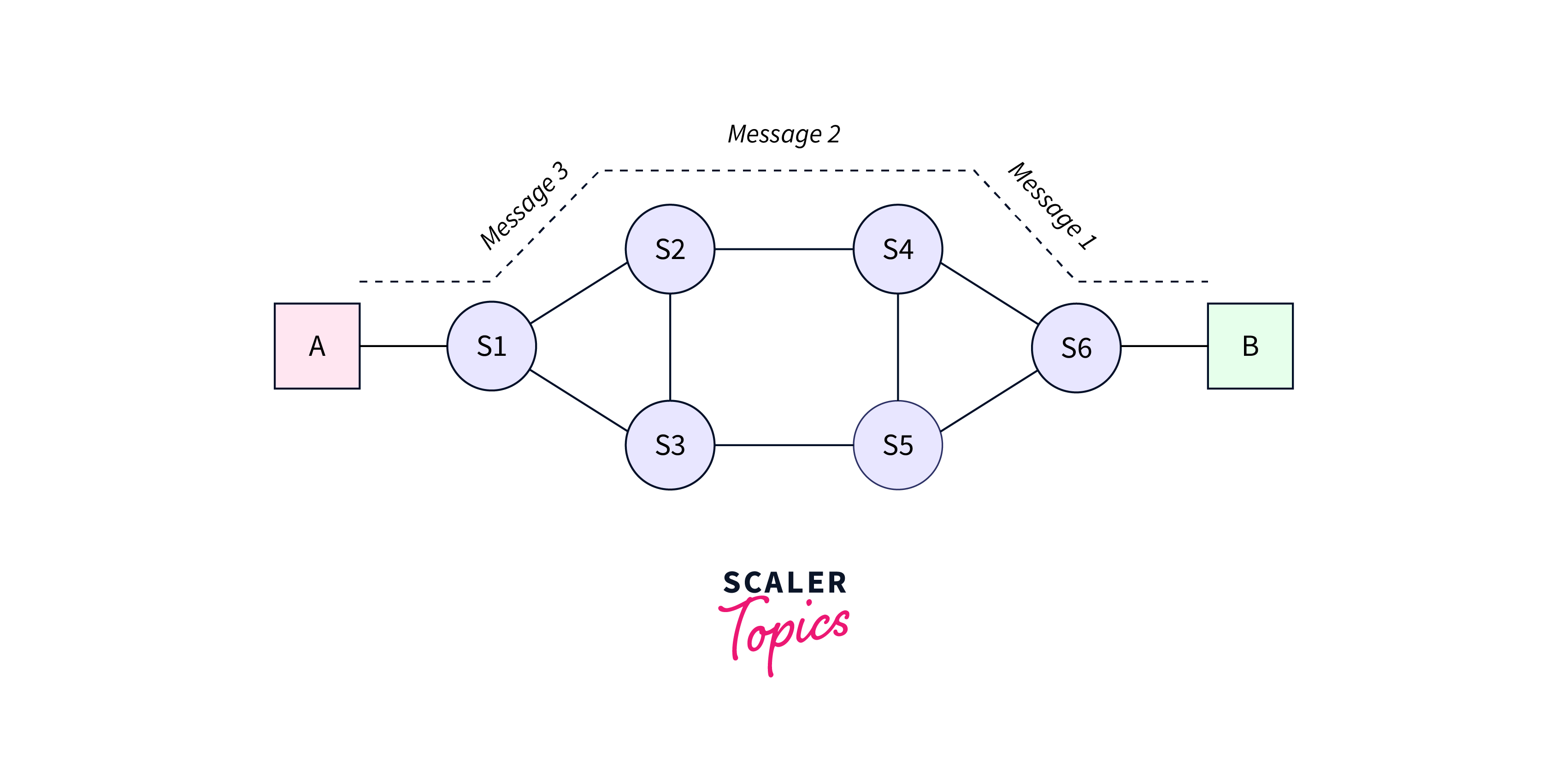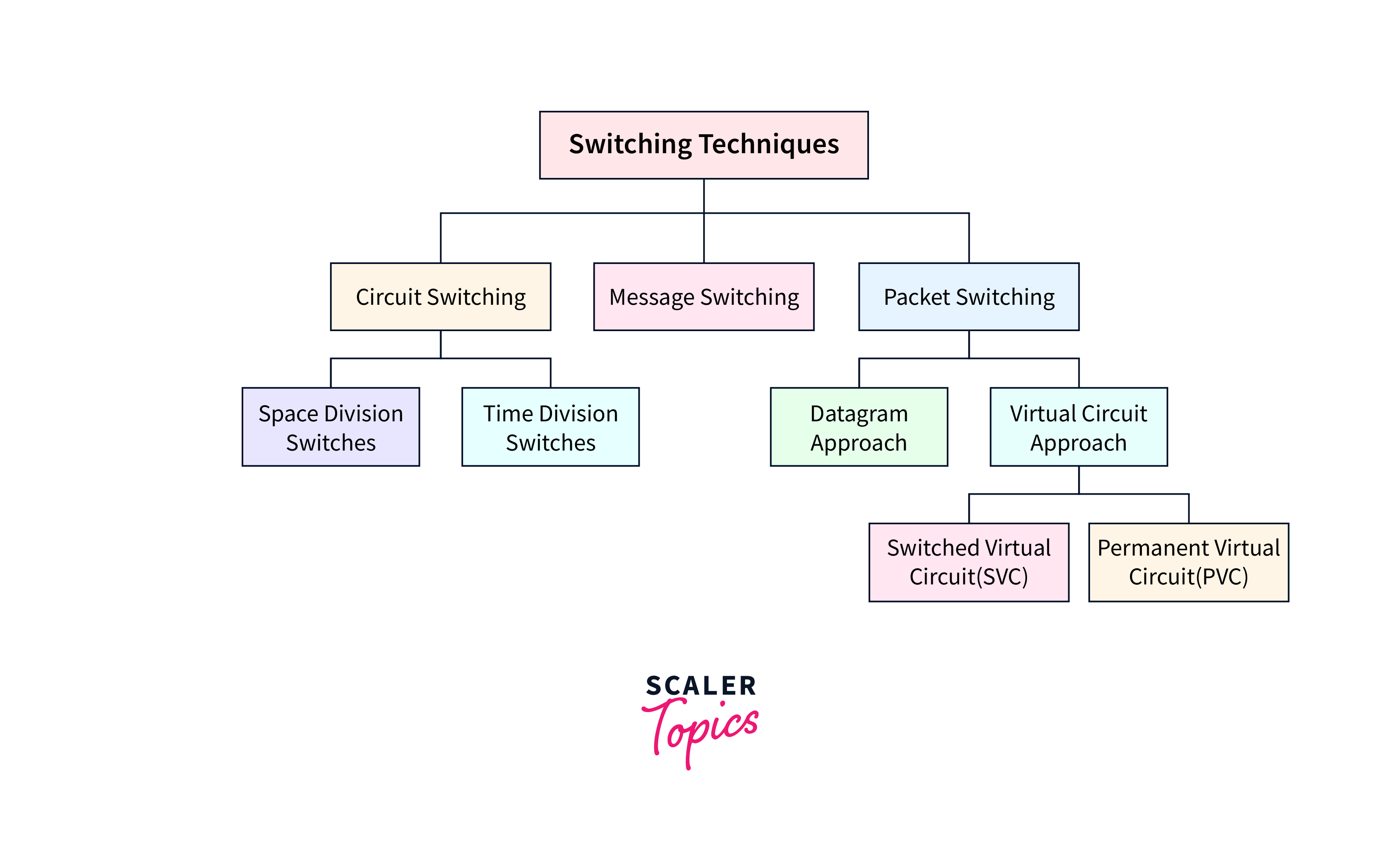Circuit Switching in Computer Network
Overview
Circuit switching is a connection-oriented service that sends and receives data via a dedicated path. In circuit switching, it is necessary to establish an end-to-end path before delivering any data from the source to the destination. Due to the dedicated circuit path, circuit switching has the lowest probability of data loss. Still, a lot of bandwidth is wasted because other senders cannot use a path during congestion.
What is Circuit Switching?
Circuit switching is a connection-oriented switching method used in computer networks where a dedicated communication path is established, maintained, and terminated for each communication session between two stations.

A complete end-to-end path in the circuit switch network is required before any communication may take place. When a user wants to send data, audio, or video, a request signal is sent to the receiver, and the receiver responds with an acknowledgment to ensure that the dedicated path is available. After receiving acknowledgment, the data is sent along a predefined path. Previously circuit switching was used in public telephone networks for voice transmission, but in the current scenario, it is replaced by virtual circuits.
However, it is considered inefficient compared to packet switching, as the channel capacity is fully dedicated for the duration of the connection. This means that if no data is being transmitted, the channel capacity is wasted.
Phases of Circuit Switching
Circuit switching involves three phases:
Circuit Establishment
- This phase is also called as setup phase.
- In this phase, a dedicated connection is established directly between two nodes or from the source to the destination using a series of switching centres.
- The sender at the source and the receiver at the destination send communication signals to request and acknowledge the establishment of the circuit.
Data Transfer
- The data transfer phase continues for the duration of the communication.
- Once the circuit is established, data (voice or other signals) is transmitted over the dedicated circuit between the sender and receiver.
- During this phase, the resources are exclusively allocated to ongoing communication, ensuring a constant quality of service.
Circuit Disconnect
This phase is also called the teardown phase. During this phase, one of the two endpoints sends a message to initiate disconnection, resulting in the termination of the communication path, which includes the intermediate links.
Types of Switches in Circuit Switching
There are two types of switches used in circuit switching:

Space Division Switches
Space Division Switching is a form of circuit switching in which separate sets of crosspoints are used to establish transmission paths. This technique leverages crossbar switches, which can be metallic crosspoints or semiconductor gates that can be enabled or disabled by a control unit. One significant advantage of Space Division Switching is its high speed, high capacity, and ability to provide nonblocking switches. However, the blocking level depends on the number of crosspoints used.
Time Division Switches
The time-division switching is a technique that involves routing multiple connections along a common trunk line. This method utilizes time-division multiplexing to divide the connections into segments, ensuring that these segments are transmitted at predefined intervals. The detection of these segments is achieved by employing a de-multiplexer device.
Advantages of Circuit Switching
- Simple Network Design:
Circuit-switched networks offer simpler network structure and routing algorithms than packet-switched networks, which require complex routing and switching methods. - Security:
Compared to shared resources in packet-switched networks, the dedicated nature of the circuit can provide a certain amount of security by lowering the risk of eavesdropping or data interception. - Reliability:
Since the dedicated communication line is reserved for the duration of the connection, circuit switching offers a high level of reliability. This guarantees that the data will be sent without loss or deterioration. - Fixed Bandwidth:
The dedicated circuit ensures that the available resources are reserved and guaranteed for that particular connection by offering a defined amount of bandwidth for the duration of the communication. - Quality of Service (QoS):
Circuit switching ensures quality of service, which implies that the network can prioritize specific types of traffic, such as audio and video, over others, such as email and web browsing. - Low Latency:
Circuit switching often offers lower latency than packet-switched networks due to the dedicated circuit. This is especially important for real-time applications such as voice conversations and interactive communication.
Disadvantages of Circuit Switching
- Inefficient use of resources:
Circuit switching creates a dedicated communication path between two nodes, which leads to the allocation of resources like bandwidth and switch ports exclusively for the duration of the communication. However, this approach can be inefficient since the reserved resources may go unused during downtime or no communication. - Vulnerability to failures:
The use of dedicated communication paths in circuit switching exposes the network to possible failures like cable cuts or switch malfunctions. If such failures occur, the communication path needs to be re-established, which can lead to delays and potential data loss. - High setup time:
Circuit switching necessitates a large amount of setup time to establish a dedicated communication link between two nodes. This can lead to communication delays. - Limited scalability:
Circuit switching is not easily scaled. As the number of users and communication demands grow, the network infrastructure must be expanded to handle more dedicated circuits, which can be costly and complex. - High Cost:
The dedicated nature of circuits and the need for specialized equipment contribute to higher costs than more efficient packet-switching technologies. - Limited Features:
Circuit-switched networks have limited features beyond simple point-to-point voice communication, making them less adaptable for multimedia, data, and interactive applications.
Formulas in Circuit Switching
- Transmission rate is given by:
- Transmission time is given by:
- Total time taken to send a packet to its destination:
Let's see the following question to understand the practical aspects of the above formulas.
Question: What is the total time taken to transmit a file of size x bits from host A to host B over a circuit-switched network that utilizes Time Division Multiplexing (TDM) with h slots and operates at a bit rate of R Mbps? The network has a circuit establishment time of k seconds.
Solution:
- Transmission Rate = Bit rate / Number of slots = bits/second.
- Transmission time = File size / Transmission Rate = = .
- Total Time = Transmission time + Circuit setup delay = seconds.
Real-world Applications of Circuit Switching
- Traditional Telephone Networks:
Circuit switching was the foundation of early telephone networks. When you dial a phone number, a dedicated circuit is established between you and the person you were calling for the duration of the conversation, providing consistent voice quality. - Satellite Communications:
Circuit switching can be used to establish connections between ground stations and satellites in various satellite communication systems, particularly those requiring consistent and reliable connections. - Video Conferencing:
Even though packet switching is commonly used in modern video conferencing, circuit switching can still be employed in specific high-quality setups that necessitate dedicated resources to ensure uninterrupted video and audio streams. - ATM and Banking Networks:
Certain ATM (Automated Teller Machine) networks and banking systems might use circuit switching to enable secure and dependable communication for financial transactions. - Military Communications:
Circuit switching can be used in secure military communications to create encrypted and dedicated communication lines, ensuring confidentiality and reliability in critical circumstances.
FAQs
Q. What are the various switching techniques?
A: There are three different types of switching techniques in computer networks:
- Circuit switching:
Circuit Switching is a method of switching that establishes a dedicated path between the transmitter and the receiver. - Message switching:
Message Switching is a switching method that transmits a complete message and routes it through intermediary nodes where it is stored and transmitted. The Message Switching technique has no defined path between the sender and the recipient. - Packet switching:
Packet Switching is a switching mechanism that divides a message into smaller bits and sends them separately rather than all at once.
Q. Do we still use circuit switching?
A: Circuit switching is still used, especially for phone conversations in places like traditional phone lines. However, for things like sending messages and using the internet, a different method called packet switching is more popular nowadays.
Q. Why is circuit switching not efficient?
A: Circuit switching is inefficient because it reserves dedicated resources for the entire call duration, even when not in use. This leads to resource wastage and limited adaptability compared to more flexible technologies like packet switching.
Conclusion
- Circuit switching is a connection-oriented service that sends and receives data via a dedicated path.
- In circuit switching, it is necessary to establish an end-to-end path before delivering any data from the source to the destination.
- Circuit switching involves three phases: circuit establishment, data transfer, and circuit disconnection.
- Space Division Switching is a form of circuit switching in which separate sets of crosspoints are used to establish transmission paths.
- The time-division switching is a technique that involves routing multiple connections along a common trunk line.
- Circuit-switched networks have simpler design and routing, offer security through dedicated connections, ensure high reliability, provide fixed bandwidth, prioritize data for quality, and have low latency, making them suitable for real-time communication.
- Circuit switching inefficiently allocates dedicated resources, is vulnerable to failures, has high setup time, limited scalability, higher costs, and lacks versatility for advanced applications.
